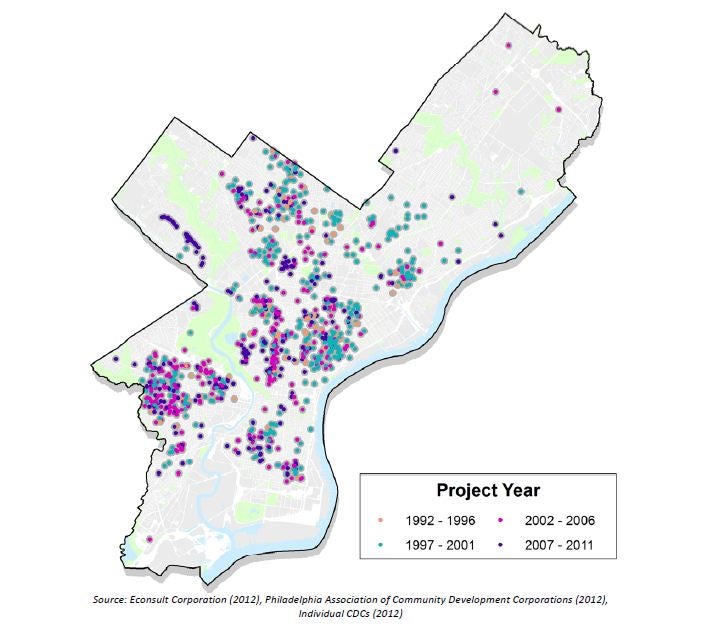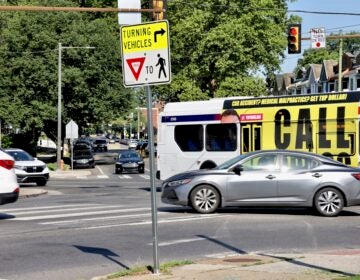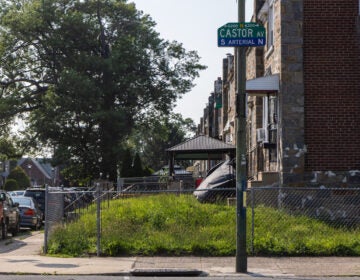Report: CDCs contributed $3.3 billion to local economy since 1992

Community development corporations in Philadelphia have made a combined, direct contribution of $2.2 billion to the local economy over the past 20 years, according to a report issued Wednesday morning by the Philadelphia Association of Community Development Corporations. Since 1992, CDCs’ investments have also contributed to another $1.1 billion in spending in Philadelphia, created 11,600 local jobs, and added $28 million to the City’s tax rolls, according to the report.
The report issued Wednesday by PACDC is based on a study performed this fall by EConsult Corporation, which surveyed 44 local CDCs about construction projects and revitalization programs as well as other investments undertaken over the last two decades. The research was funded by Citi Community Development, a subsidiary of financial services corporation Citigroup Inc.
A reflection of the first study on the economic impact of local CDCs, the report comes out as PACDC, a nonprofit consortium of those groups, celebrates its 20th anniversary. Community development corporations are diversely funded organizations—the largest portion of most of their operating budgets is the almost thirty percent that comes from earned income, according to the report, with other sources coming from city, state and federal governments, as well as corporations, individuals and private foundations. Most of their investments are focused on construction and rehabilitation, but the mix of building and other programs CDCs undertake varies widely by neighborhood.
“I think a lot of people understand that CDCs benefit a number of people directly,” said PACDC Executive Director Rick Sauer in an interview with PlanPhilly on Monday, “whether it’s people that move into new homes, maybe are able to get a job in a small business that’s set up—but as we talked this issue through, we think there was a lack of understanding of what the larger, overall economic impact is of this work … And we felt there would be real value in doing an industry-wide survey and analysis of their work over the last 20 years, which happens to coincide with how long PACDC has been around.”
Data for the report was collected directly through a survey of local CDCs, from various city agencies—including the Commerce Department and the Office of Housing and Community Development—and from IRS tax forms. Lee Huang, director of Econsult Corporation, was the lead researcher on the economic impact study.
Among the other findings of the report:
- CDC investments raised property values by $680 million citywide by “transforming blight through new construction and vacant property clean-up”
- Ongoing programs and services of CDCs sustain 3,400 jobs in Philadelphia and contribute $4.3 million in local tax revenue every year
- Statewide, CDC investments created an additional $2.9 billion in indirect spending
- CDC investments in housing construction and rehabilitation is remarkably consistent even in fluctuating markets; CDCs have spent more than $850 million on such investments since the beginning of the recession in 2007
- Homes near CDC projects are worth an average of $4,000 more apiece than they would have been without those investments
“One of the ways in which the city was able to weather the recession is that we have strong CDCs and strong institutions—academic and medical, Eds and Meds—[which] continued to build new buildings and renovate,” said Lee Huang, of EConsult. “So yes, we got bitten by the recession, but at the same time there was still hundreds of millions of dollars in construction taking place, so that was able to absorb some of the slacking construction demand during that painful time.”
Lynn Haskin, director of external affairs at PACDC, stressed that although the numbers in the report are impressive, they only conservatively estimate the financial investments of CDCs and also leave out some of the most significant benefits of CDCs’ work.
“[CDCs] work is holistic,” Haskin said. “They look at their neighborhoods holistically. If there’s a need there, they’ll look to fill it.”
Lee Huang also emphasized that the work of CDCs’ is in some ways more complicated than simply running a business for profit.
“What CDCs do on a daily basis is very difficult …” Huang said. “You have to find that intersection between what are you good at, what does the market need, who’s willing to pay for that, and how do you do that in a particular geographic and political environment? And in many ways, that is a much harder equation to make work than a business figuring out a way to make money. So I think that what CDCs do here is very impressive.”
PACDC director Rick Sauer said that one of the most telling findings in the study is the suggestion of what shape Philadelphia’s neighborhood economies would be in without the steady investment of CDCs.
“You can imagine how much different Philadelphia’s neighborhoods would be right now if [CDCs] hadn’t been sweating all those years to start turning neighborhoods around before new investment was attracted,” Sauer said. “… As far as the quality of life in those neighborhoods and how much worse things would have gotten if you hadn’t had those interventions, that’s an important side of the coin that I think should impact public policy decision making.”
Sauer said that PACDC supports the development of a land bank in the city, and will advocate for one with an “appropriate disposition system” that complements the work of neighborhood CDCs , many of which have proven capable of effectively revitalizing vacant land. He said that PACDC would use the report to “advocate for policy that make our members’ jobs easier,” and to help guide strategic investments from the city and other entities.
“It would be fantastic if the City decided to put a little more general fund money into supporting the work of the CDCs,” Sauer said. “That would be a wonderful outcome of the study.”
Contact the reporter at jbrey@planphilly.com and follow him on Twitter @jaredbrey
WHYY is your source for fact-based, in-depth journalism and information. As a nonprofit organization, we rely on financial support from readers like you. Please give today.






